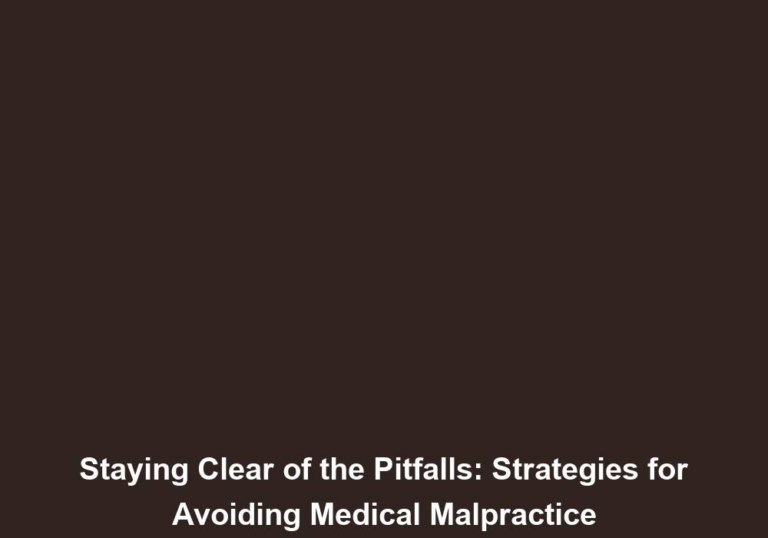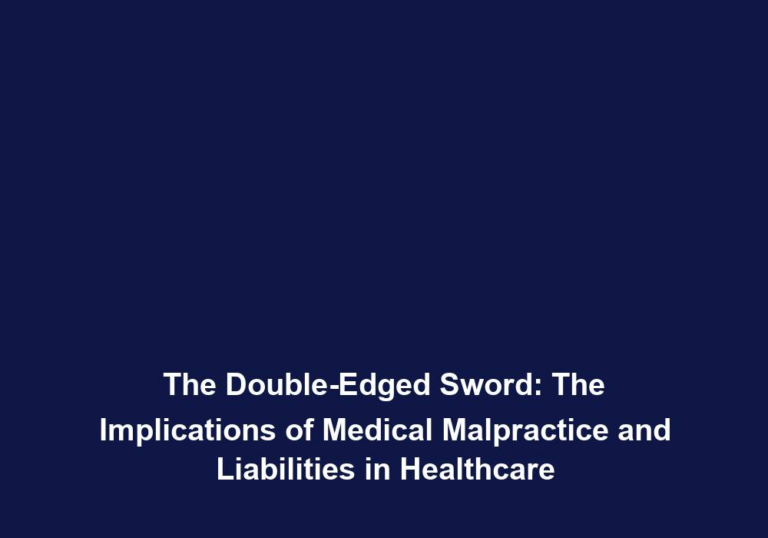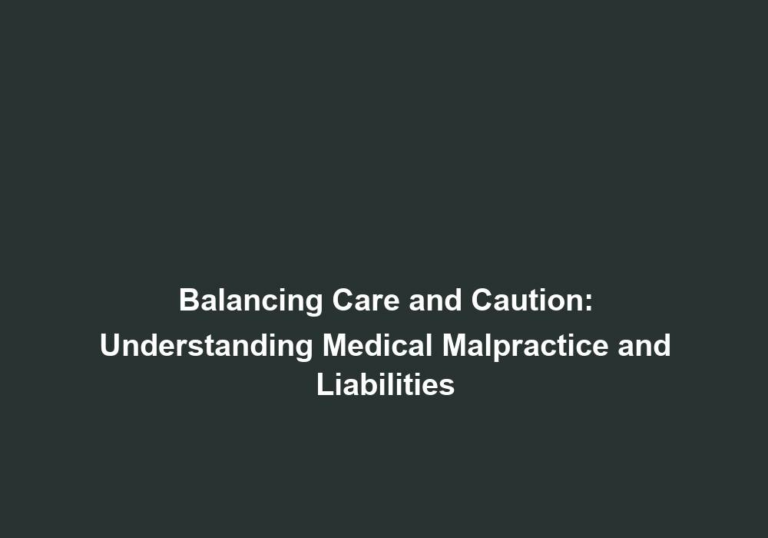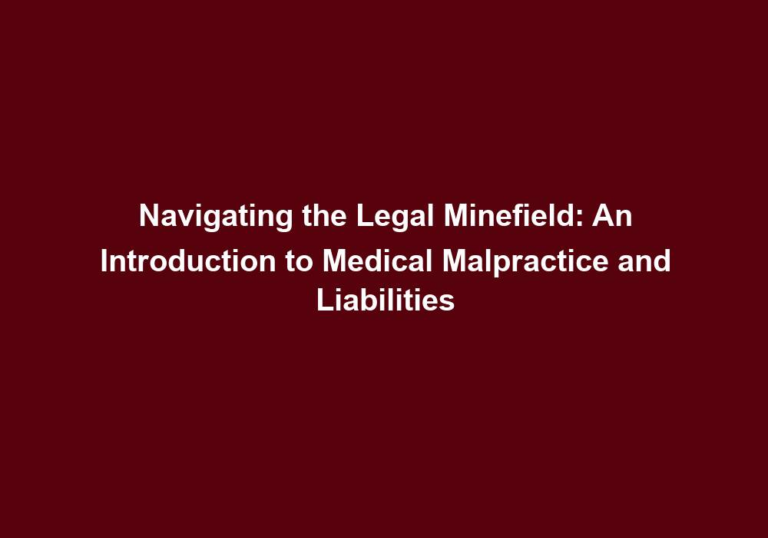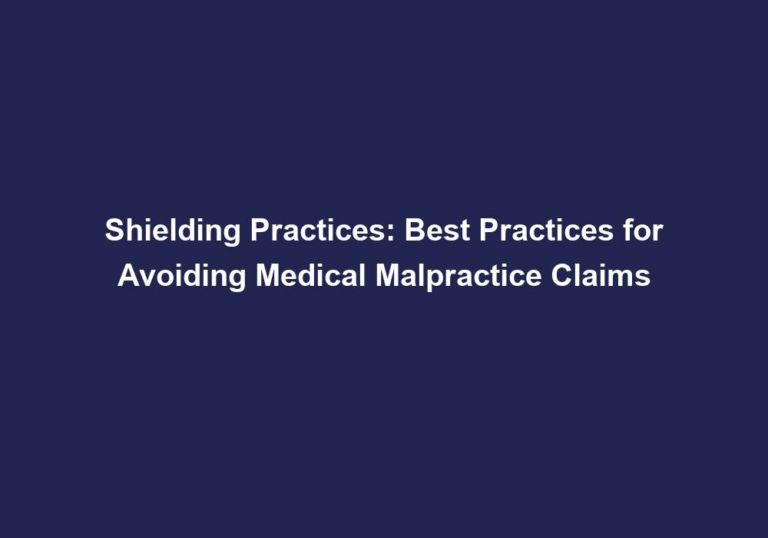Beyond the Claim: Medical Malpractice Legal Actions and Defenses Explained
Medical malpractice is a complex area of law that deals with instances where healthcare professionals fail to meet the standard of care, resulting in harm or injury to a patient. When medical negligence occurs, legal actions may be taken to seek compensation for the damages suffered. However, it is important to understand the various legal actions and defenses involved in medical malpractice cases to navigate the complexities of the legal system effectively.
Legal Actions in Medical Malpractice Cases
1. Negligence Claims
The most common legal action in medical malpractice cases is a negligence claim. Negligence claims are based on the principle that healthcare professionals owe a duty of care to their patients. To establish a negligence claim, the plaintiff (the injured patient) must prove the following elements:
- Duty of care: The healthcare professional owed a duty to provide a standard of care to the patient. This duty arises from the doctor-patient relationship.
- Breach of duty: The healthcare professional failed to meet the standard of care expected in similar circumstances. This can be established by presenting evidence of actions or omissions that deviated from the accepted medical practices.
- Causation: The breach of duty caused harm or injury to the patient. The plaintiff must establish a direct link between the healthcare professional’s negligence and the harm suffered.
- Damages: The patient suffered measurable damages as a result of the healthcare professional’s negligence. These damages may include physical pain, emotional distress, medical expenses, and loss of income.
When presenting a negligence claim, it is important to gather all relevant medical records, expert opinions, and witness testimonies to support the case. This evidence will help establish the standard of care, demonstrate the breach of duty, prove causation, and quantify the damages suffered by the patient.
2. Informed Consent Claims
Informed consent refers to the process by which patients are adequately informed about the potential risks, benefits, and alternatives of a medical procedure or treatment before giving their consent. If a healthcare professional fails to obtain informed consent, a patient may bring an informed consent claim. Proving an informed consent claim requires establishing that:
- The healthcare professional did not provide sufficient information about the risks and alternatives. This can be demonstrated by showing that the patient was not made aware of potential complications or alternative treatment options.
- The patient would have made a different decision if adequately informed. This can be proven by presenting evidence of the patient’s decision-making process and how it would have been influenced by accurate and complete information.
Informed consent claims often require expert testimony from medical professionals to explain the standard practices for obtaining informed consent and to support the argument that the patient would have made a different decision if adequately informed. It is crucial for patients to document all conversations and written materials related to informed consent to strengthen their claim.
3. Breach of Contract Claims
In some instances, medical malpractice cases may involve breach of contract claims. These claims arise when patients can show that a healthcare professional failed to fulfill the terms of a contract, resulting in harm or injury. It is essential to review the specific contractual provisions and obligations to determine the viability of a breach of contract claim.
To establish a breach of contract claim, the patient needs to prove the following elements:
- Existence of a valid contract: There must be a valid contract between the healthcare professional and the patient, either express or implied.
- Breach of contract: The healthcare professional failed to fulfill the terms of the contract. This can include failing to provide agreed-upon treatment, deviating from the agreed-upon standard of care, or breaching any other contractual obligations.
- Causation: The breach of contract caused harm or injury to the patient. The plaintiff must demonstrate a direct link between the healthcare professional’s breach of contract and the damages suffered.
- Damages: The patient suffered measurable damages as a result of the breach of contract. These damages may include physical injuries, emotional distress, and financial losses.
Breach of contract claims require a careful examination of the contractual terms and evidence to support the breach of contract allegations. It is advisable to consult with an experienced attorney to assess the strength of a breach of contract claim in a medical malpractice case.
Potential Defenses in Medical Malpractice Cases
1. Standard of Care Defense
A common defense in medical malpractice cases is arguing that the healthcare professional met the accepted standard of care. This defense aims to demonstrate that the defendant’s actions or treatment decisions were in line with what other reasonably competent healthcare professionals would have done in similar circumstances. Expert testimony from medical professionals is often crucial in establishing the standard of care.
To prove the standard of care defense, the defendant must present evidence showing that their actions were consistent with the prevailing medical practices and guidelines. This can include medical literature, professional guidelines, and expert opinions that support the defendant’s treatment decisions. It is important to note that the standard of care may vary depending on the specific medical specialty and the circumstances of the case.
2. Contributory Negligence Defense
The contributory negligence defense asserts that the patient’s own actions or negligence contributed to their own injuries. If the defendant can prove that the patient failed to follow medical advice, did not disclose crucial medical information, or engaged in risky behavior that led to the harm, it may reduce or eliminate the defendant’s liability.
To establish a contributory negligence defense, the defendant must demonstrate that the patient acted unreasonably and that their actions directly contributed to the harm suffered. This defense requires presenting evidence of the patient’s non-compliance with medical instructions, failure to disclose pertinent medical history, or engagement in activities that increased the risks associated with the treatment. The degree to which contributory negligence affects the defendant’s liability varies by jurisdiction.
3. Statute of Limitations Defense
Every jurisdiction has a statute of limitations that sets a time limit for filing a medical malpractice lawsuit. If the patient fails to initiate legal action within the specified timeframe, the defendant can raise the statute of limitations defense, asking the court to dismiss the case. It is crucial for patients to be aware of these time limits to avoid losing their right to seek compensation.
The statute of limitations defense requires the defendant to prove that the patient filed the lawsuit after the specified time limit had expired. It is important to consult with an attorney to determine the applicable statute of limitations in a medical malpractice case and ensure timely filing of the lawsuit.
4. Good Samaritan Laws
Good Samaritan laws protect healthcare professionals who provide emergency medical care in good faith at the scene of an accident or in an emergency situation. These laws shield them from liability if their actions result in unintended harm, provided they acted reasonably and within the scope of their training.
Good Samaritan laws vary by jurisdiction but generally offer protection to healthcare professionals who render emergency assistance without expecting compensation. These laws encourage healthcare professionals to provide immediate medical aid without fear of legal repercussions. It is important to consult the specific provisions of the Good Samaritan laws in the relevant jurisdiction to understand the scope and limitations of the protection they offer.
Conclusion
Medical malpractice legal actions involve complex processes and require a thorough understanding of the various legal actions and defenses. Whether it’s a negligence claim, informed consent claim, or breach of contract claim, patients must gather evidence, seek expert opinions, and work closely with experienced attorneys to effectively present their case. Similarly, healthcare professionals need to understand the defenses available to protect their interests. By being aware of the legal landscape surrounding medical malpractice, both parties can navigate the legal system with greater confidence and ensure that justice is served.


